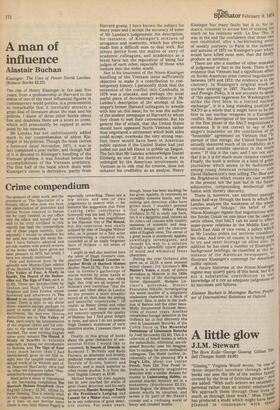Crime compendium
The pressure of other work, and the presence at The Spectator of a literary editor who does not have the appreciation of detective and thriller fiction required to harass me for copy (indeed, at our office only the editor and myself can be said to be truly civilised in this regard) has kept the compendium out of these pages recently. Consequently I intend to abandon for the next few weeks the essay format I have hitherto adopted and provide readers with potted reviews of the books which have given me most pleasure in 1973, but which I have not already mentioned.
First and foremost must be the splendid new Murray/Cape edition of the Sherlock Holmes long stories (The Valley of Fear, A Study in Scarlet, The Hound of the Baskervilles and The Sign of Four, each at £1.95). There are introductions by Graham and Hugh Greene, Len Deighton and John Fowles, whose foreword and afterword in The Hound is an exciting model of criticism. There is little to say about these classics except perhaps to point to some of their individual excellences; the best-ever Holmes deductions are in The Valley of Fear, particularly his interpretation of the original cipher and his solution to the matter of the missing dumbell. The most exciting English crime story remains The Hound. A Study in Scarlet is valuable especially as being our introduction to Holmes, and The Sign of Four (very much better than I had remembered) gives us our first insight into the tangled marital and sexual world of Dr Watson, part of, as Desmond MacCarthy once told us, what the Germans called "Watsonischechronologieprobleme."
MacCarthy's essay is reproduced in the fascinating compilation The Sherlock Holmes Scrapbook (New English Library £3.50), edited by Peter Haining. This is exactly what its title suggests, but, concentrating as it does on less familiar items (there is very little Sidney Paget) is especially rewarding. There are a few errors and one or two judgements to quarrel with — for instance the suggestion that Peter Cushing (who contributes a foreword) was the best TV Holmes ever. Certainly, he was magnificent in the Hammer film of The Hound, but his television was easily eclipsed by that of Douglas Wilmer who, as is proper to a fine actor reinterpreting a classical role, reminded us of an easily forgotten facet of Holmes — his sense of humour.
I might as well also mention here the latest of Hugh Greene's compilations The Crooked Counties — Further Rivals of Sherlock Holmes (Bodley Head £2.75). This is the latest in Greene's gatherings of stories written by other hands at the time when Holmes was riding high: this crop are all inspired by Holmes's own conviction "that the lowest and vilest alleys in London do not present a more dreadful record of sin than does the smiling and beautiful countryside." Of course, as Benny Green and other critics have said, these stories do not remotely approach the quality of Holmes: but I find great delight in them, and since I do not possess Hugh Greene's storehouse of early detective stories, I treasure them as well.
Finally, in this group of books about the great characters of sensational fiction I would like to commend, In Search of Dracula by Raymond T. McNally and Radu Florescu, an admirable and lavishly produced volume which covers the Dracula of fiction, history and folklore, and is much superior to other recent studies. It is from the New English Library at £3.00.
Michael Innes's Sir John Appleby has by now reached the status or great classic detective, and his early adventures Hamlet Revenge! Death at the President's Lodging and Lament for a Maker must certainly be in any collection of great detective stories. For some years,
though, 1nnes has been slacking: he has given Appleby, in retirement, an incredibly tiresome family, and his writing and detection alike have grown slack. I wouldn't pretend that Appleby's Other Story (Gollancz £1.75) is really top form, but it is a delightful read, renews all Sir John's old concern with country mansions of eccentric and magnificent design, and the obscurer sides of English verse. The owner of a great house is murdered; Appleby unwillingly investigates, and threads his way to a solution through a splendidly typical galere of weird and whimsical Innes characters.
During the year Gollancz also gave us, at £2.10, a most unusual minor classic, Ivy Litvinov's His Master's Voice, a study of police procedure in Moscow in the 1920s by the wife of the distinguished Soviet diplomatist. Madame Litvinov's policeman, District Procurator Nikulin, investigating the weird murder of a singularly unpleasant character in a block of workers' flats, is quite in the tradition of Barlow and the other beautifully documented fictional detectives of recent years. Another remarkable foreign detective in the Gollancz list (a real discovery this one) is Lieutenant Boruvka of the Czech force in The Mournful Demeanour of Lieutenant Boruvka by Josef Skvorecky (£2.50). This is a collection of linked stories in which the melancholic, whimsical, sex-obsessed Boruvka uses his imagination to outleap his more methodical colleagues. Tim Heald (author, incidentally of the pleasing It's a Dog's Life, about our canine friends, from Elm Tree Press) introduces a similarly imaginative detective with a similar distaste for
routine in Unbecoming Habits, an unusual murder mystery set in a monastery (Hutchinson £2.25).
Simon Bognor, the detective, works almost wholly by intuition, and seems a fit part of Mr Heald's strange and a confusing world of boozy and crooked monks.


































 Previous page
Previous page